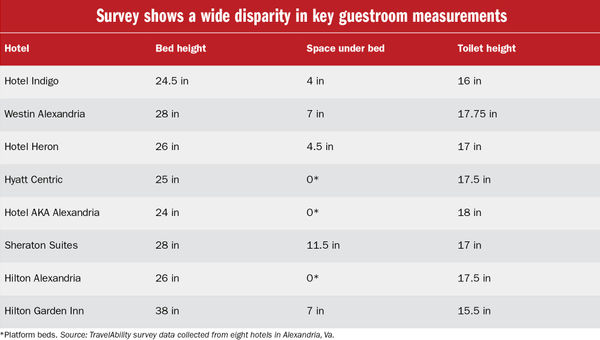Here’s what I don’t get: Hotels have spent millions of dollars to comply with the physical requirements of the Americans With Disabilities Act, but many won’t spend a few hours creating a landing page on their website describing their accessibility features — including accurate dimensions of their features, which is critical information for travelers with disabilities.
Jake Steinman is founder and CEO of TravelAbility, a platform dedicated to educating the travel industry about the importance of inclusivity and providing resources to enhance the travel experience for people with disabilities.
The best amenity you can provide for guests in wheelchairs — the surest way to make them feel welcome at your hotel — is to post that data, aka provide information transparency. It’s not much harder than providing fresh-baked cookies or free bottles of water to welcome travelers. And it lasts a lot longer.
A hotel room can meet all the physical requirements of the ADA and turn out to be inaccessible for many wheelchair users. One size doesn’t fit all; one size fits one! Here’s a bit of history: The ADA, which was passed in 1990, took over a year to write after back-and-forth from advocates, architects, business leaders, disability groups and, of course, lawyers. The result was that it was written for the median, which means it works for half the people and doesn’t work for the other half. For wheelchair users, since there’s no clear ADA information on most hotel sites, they don’t know which half they’re in until they arrive.
Few hotels are publishing information for a wheelchair user to know if the room will work for them. Would-be guests must play either online detective or Russian roulette and hope for the best. That may explain why, according to the most recent market report by the Open Doors Organization and Harris, only 15% of people with disabilities travel.
At TravelAbility we launched “Heads in Accessible Beds,” a pilot program with four destinations to collect and share essential data on sleeping room bed heights, bathrooms and pool lifts. In the chart above are some early results submitted from eight participating hotels in Alexandria, Va., that revealed there was a 14-inch variation in bed height from just eight properties.

*Platform beds. Source: TravelAbility survey data collected from eight hotels in Alexandria, Va.
Hypothetically, there may be three guests with different mobility needs.
Guest A is a power-chair user who may find the Westin, Sheraton or Hilton Garden Inn most suitable, as those properties have the most space under the bed for a Hoyer lift.
Guest B uses a manual chair, and the Indigo or AKA hotels may work best for her as their beds are lower and easier to transfer into.
Guest C is 79 years old, uses a walker and has difficulty transitioning from sitting to standing. The Westin Alexandria, with its highest toilet, would be a good selection.
This information will be made available on the dedicated accessibility page on each DMO’s website, ensuring that wheelchair users, as well as travel advisors booking clients with mobility challenges, have access to the information they need to make informed travel decisions.
But hotels should include an accessibility page on their website that also includes photos of accessible rooms as well as descriptions. Every image and data point sends a welcoming message to travelers with disabilities.
I know some hotel managers believe that providing information may expose them to risk, perhaps sparking an ADA complaint. But the opposite is true: By posting details and images about your compliant features, not only is it helpful for guests, but it also greatly reduces front desk complaints and, according to Stefan Muhle, vice president and regional manager at Noble House Hotels, “it actually protects us from ADA litigation.”
As a best practice example, here’s a link to the accessibility page for the Argonaut, one of their San Francisco hotels.
And finally, last October the U.S. Supreme Court refused to hear a “tester” case against the Cottage Inn and Suites in Wells, Maine, over a lack of information about accessibility on their website. In the interim, the hotel corrected the problem by adding the following to the contact page on their site: “Please Note: Unfortunately, we do not have the capabilities to provide ADA-compliant lodging. We apologize for the inconvenience! If you or someone in your party has any physical challenges, please call us, and we will do our absolute best to accommodate.”
One last tip: Adding an accessibility page to your website will not only be welcoming for people who are disabled today but also for the 73 million boomers, 40% of whom, according to the website Health Day, self-identify as having had a disability when they turned 65. With an average net worth of $1.2 million and the time to travel during shoulder and off-seasons, adding an accessibility page to your website may be the most affordable way to “future-proof” your hotel. And if you are offering free cookies, make sure they are not placed too high for a guest using a wheelchair to reach them. They’ll appreciate it!
________________________________
Travel Weekly accepts opinion pieces on subjects of interest to the travel industry and, most importantly, to travel advisors. Forums should be 550 words and must be exclusive to Travel Weekly; no part of the writing can have been published anywhere else. Forums must not be self-promotional and should be submitted with the understanding that Travel Weekly reserves the right to edit the content for length, style, spelling, clarity, structure, etc. Submissions, along with a high-resolution headshot and a short bio, should be emailed to editor in chief Arnie Weissmann and deputy managing editor Gerry Bourbeau.








:max_bytes(150000):strip_icc()/roundup-writereditor-loved-deals-tout-f5de51f85de145b2b1eb99cdb7b6cb84.jpg)


